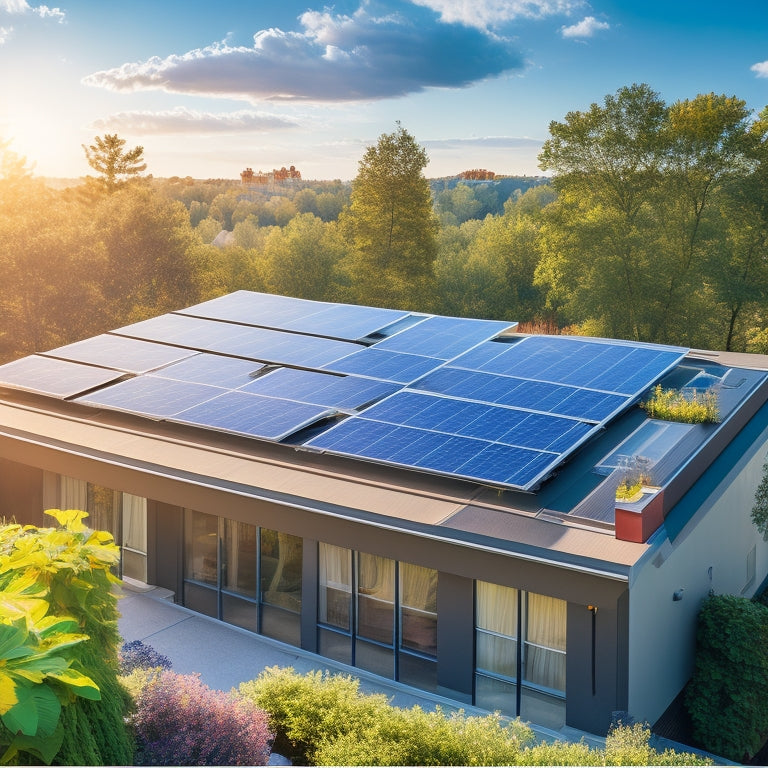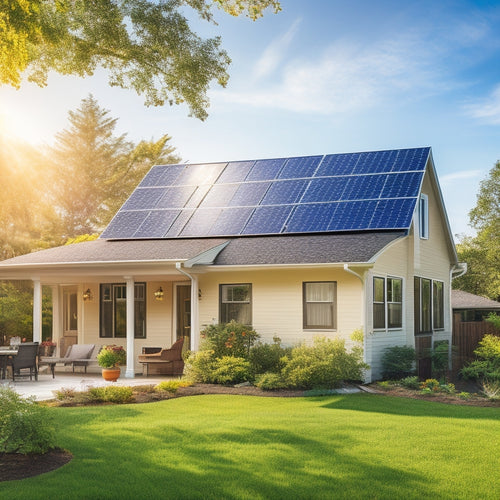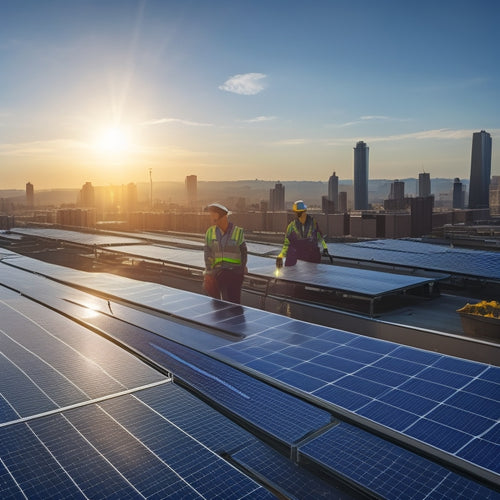
Top-Rated Solar Panel Systems: Expert Reviews Revealed
Share
You're looking for top-rated solar panel systems, right? Experts agree the best options boast efficiency ratings over 22%, with advanced PERC and bifacial cell technologies. Durability and long-term warranties are critical—think tempered glass and high-grade silicon. For cost-effectiveness, aim for solar kits around $0.80 to $1.00 per watt, featuring monocrystalline panels. Premium systems integrate seamlessly with advanced inverters and lithium-ion batteries for robust energy storage. Easy-to-install models with weather resistance and structural integrity shine. Performance guarantees promise at least 80% efficiency after 25 years. Want to uncover the finest in solar technology and find the perfect fit for you?
Key Takeaways
- Leading efficiency ratings above 22% utilizing advanced PERC and bifacial cell technologies.
- Premium systems offer robust warranties, ensuring long-term performance and peace of mind.
- High-quality materials and construction provide durability against extreme weather conditions.
- Cost-effective options available with average costs around $0.80 to $1.00 per watt.
- Advanced energy storage solutions integrate lithium-ion batteries for enhanced efficiency and independence.
Best Overall Solar Panels
https://www.youtube.com/watch?v=GEZO67JJ19I
When evaluating the best overall solar panels, it's important to take into account efficiency ratings, durability, and warranty terms to make an informed decision. High efficiency ratings guarantee you're maximizing energy production, translating sunlight into significant energy savings.
Durability is essential; you want panels that withstand harsh weather conditions and continue performing at their best over decades. Warranty terms give you peace of mind, covering potential failures or performance degradation.
Aesthetic appeal shouldn't be overlooked. Sleek, modern designs can seamlessly blend with your home's architecture, enhancing its visual appeal while delivering top-tier performance. Brands like SunPower and LG offer panels that not only perform exceptionally but also look great, merging form with function.
Don't forget the environmental benefits. Solar panels reduce reliance on fossil fuels, cutting down your carbon footprint. Opt for brands that emphasize sustainability in their manufacturing processes, like REC and Panasonic. These companies use eco-friendly materials and prioritize recycling, aligning your investment with broader environmental goals.
Most Efficient Solar Panels
You'll find the most efficient solar panels typically boast leading efficiency ratings of over 22%.
These panels utilize advanced solar technologies like PERC and bifacial cells to maximize energy capture.
Analyzing performance metrics, these top-tier panels consistently outperform their counterparts in real-world conditions.
Leading Efficiency Ratings
Evaluating the leading efficiency ratings reveals that the SunPower Maxeon 3 panels currently top the list with an impressive efficiency of over 22%. This means you get more power per square foot, maximizing your roof space. These panels' high efficiency directly translates into better energy storage capabilities, ensuring you can harness and store more solar energy even when sunlight is limited.
When considering grid integration, the SunPower Maxeon 3 panels excel. Their superior efficiency reduces the strain on your storage systems and enhances the stability of your energy supply. This efficient energy conversion supports a smooth shift between your stored energy and the grid, providing you with reliable and consistent power.
Next in line, the LG NeON R panels boast an efficiency of around 21.7%. This solid performance means you'll still achieve substantial energy savings and robust grid integration.
The Panasonic HIT N330 panels follow closely with an efficiency of 20.3%, proving to be a reliable choice for both residential and commercial applications.
Advanced Solar Technologies
Several cutting-edge solar technologies are pushing efficiency boundaries, with innovations like multi-junction cells and tandem cells leading the charge. Multi-junction cells, which stack multiple layers of photovoltaic materials, capture a broader spectrum of sunlight. This results in conversion efficiencies exceeding 40%, far surpassing the traditional monocrystalline and polycrystalline cells.
Tandem cells combine different materials to optimize light absorption and energy conversion, achieving efficiencies around 30%.
When you're integrating these advanced panels into your system, don't overlook the importance of high-quality solar inverters. They convert the direct current (DC) generated by your panels into alternating current (AC) for home use. Modern inverters now boast efficiencies above 98%, minimizing energy loss and maximizing output.
Equally important are storage solutions that guarantee you can utilize solar energy even when the sun isn't shining. Lithium-ion batteries, with their high energy density and long cycle life, are the current market leaders. However, emerging technologies like solid-state batteries and flow batteries promise even greater efficiency and longevity.
Top Performance Metrics
As you consider integrating cutting-edge solar technologies, it's vital to analyze the top performance metrics that identify the most efficient solar panels available today.
The pinnacle of solar efficiency hinges on two critical factors: energy output and temperature coefficient. Evaluating these metrics guarantees you maximize every ray of sunlight.
Energy output, measured in watts, directly impacts how much electricity your solar panels can generate. The higher the energy output, the more power you'll harness, translating into greater savings and a smaller carbon footprint. Leading models like the SunPower A-Series and LG NeON R boast impressive outputs, reaching up to 400W per panel.
Temperature coefficient is another essential metric, indicating how a panel's efficiency drops as temperatures rise. Solar panels typically lose efficiency in hot conditions, so a lower temperature coefficient is desirable. For example, panels with a coefficient around -0.3%/°C, such as Panasonic HIT, outperform those with higher coefficients, maintaining better efficiency under scorching sun.
Budget-Friendly Options
You can find budget-friendly options that don't compromise on performance by focusing on affordable solar kits and high-efficiency panels.
Many systems offer cost-effective installation, reducing overall expenses while maintaining energy output.
Analyzing initial investment versus long-term savings is essential to selecting the best economical choice.
Affordable Solar Kits
When you're aiming to shift to solar energy without breaking the bank, budget-friendly solar kits offer a cost-effective solution that doesn't compromise on performance. These kits, particularly the DIY solutions, empower you to install your own system, saving on professional installation fees.
Analyzing the market, you'll find portable kits that are perfect for those who crave flexibility and convenience. With power outputs ranging from 100 to 400 watts, these kits can efficiently meet the energy needs of small appliances, RVs, and even off-grid cabins.
Data shows that the average cost per watt for these affordable kits hovers around $0.80 to $1.00, making them an attractive option for budget-conscious consumers. Technologically, they often include monocrystalline panels, known for their higher efficiency and durability, ensuring you get maximum energy output for your investment. Additionally, many kits come with inverters and charge controllers, providing a complete package for immediate deployment.
For those seeking liberation from traditional energy sources, these solutions deliver both financial and environmental benefits. Analytical insights reveal that over a 20-year span, these systems can save you thousands on electricity bills while reducing your carbon footprint, making them a prudent choice for eco-conscious individuals.
High-Efficiency Panels
High-efficiency panels that won't break the bank are becoming increasingly accessible, offering superior performance at competitive prices. You'll find these options not only boost your energy output but also maximize power density, ensuring you get the most out of your solar investment.
Take, for instance, monocrystalline panels. These high-efficiency solutions typically offer efficiencies above 20%, meaning they convert more sunlight into usable electricity compared to polycrystalline alternatives.
When selecting budget-friendly high-efficiency panels, you should look at metrics like watts per square meter. This figure represents power density and helps you understand how much power the panel generates in a given space. A higher power density means fewer panels to achieve your energy goals, translating to lower costs and less space required on your roof.
Moreover, advancements in photovoltaic technology have made these panels more affordable without sacrificing performance. Brands like LG and SunPower offer models that combine high efficiency with cost-effectiveness. Analyzing their energy output per dollar spent can liberate you from high utility bills and reduce your carbon footprint.
Cost-Effective Installation
Often, optimizing your solar investment starts with exploring cost-effective installation options that don't compromise on quality or efficiency. You can achieve substantial savings by leveraging various incentive programs and tax credits designed to make solar energy more accessible. These financial aids can greatly reduce your upfront costs, making solar adoption more feasible.
When evaluating budget-friendly installation options, consider:
-
DIY Kits: These kits allow you to install solar panels yourself, reducing labor costs. While they require some technical know-how, they offer a hands-on approach to solar energy.
-
Community Solar Programs: By participating in these programs, you share the cost of solar installations with others in your community, lowering individual expenses and enjoying collective benefits.
-
Third-Party Financing: Options like solar leases or power purchase agreements (PPAs) enable you to install solar panels with little to no upfront cost, paying instead through fixed monthly payments or based on energy consumption.
Analyzing these options with an eye on long-term savings and efficiency is essential. By utilizing incentive programs and tax credits, you can minimize initial outlays and maximize your return on investment.
Adopting solar technology not only reduces your carbon footprint but also liberates you from rising energy costs, paving the way for a more sustainable future.
Premium Solar Panel Systems
Premium solar panel systems leverage cutting-edge technology to deliver superior efficiency and durability, making them a top choice for maximizing energy output and long-term savings. When evaluating premium options, you'll find significant advancements in battery integration and inverter compatibility. These systems are designed to seamlessly store excess energy and convert it efficiently, ensuring you get the most out of every ray of sunlight.
Data shows that high-efficiency panels can achieve up to 22.8% efficiency, compared to the 14-18% range of standard panels. This means greater energy production per square meter, reducing the number of panels needed for substantial output. Additionally, premium systems often come with advanced microinverters or optimized string inverters, enhancing the system's ability to handle shading and panel mismatch issues.
From an analytical perspective, investing in premium solar panels results in a quicker return on investment. Their robust build and superior materials extend their lifespan, often backed by 25-30 year warranties. For those seeking energy independence, these systems offer a reliable solution with minimal maintenance.
Best for Durability
When considering the longevity of solar panel systems, those designed for durability incorporate advanced materials and engineering techniques to withstand harsh environmental conditions and maintain peak performance over time.
You want a system that not only delivers efficient energy but also stands the test of time. The best durable solar panels excel in three key areas: weather resistance, structural integrity, and material quality.
-
Weather Resistance: These panels are built to endure extreme temperatures, high winds, and heavy precipitation. They often feature tempered glass and robust framing to protect against environmental stressors.
-
Structural Integrity: Durable panels use reinforced mounts and frames to resist physical damage. They're engineered to remain operational even in severe weather conditions, ensuring consistent energy production.
-
Material Quality: High-grade silicon, enhanced anti-reflective coatings, and corrosion-resistant materials contribute to a long lifespan. These components don't just survive—they thrive in diverse climates.
Easy-to-Install Panels
For homeowners and businesses seeking hassle-free solar energy solutions, panels that are easy to install greatly reduce setup time and labor costs. Quick setup and user-friendly features are vital in making solar energy more accessible and appealing. Here's an analytical comparison of top-rated easy-to-install solar panels:
| Panel Model | Installation Time | User-Friendly Features |
|---|---|---|
| SunPower E-Series | 4-6 hours | Integrated microinverters, plug-and-play connections |
| LG NeON 2 | 5-7 hours | Lightweight, pre-drilled holes for easy mounting |
| Canadian Solar HiDM | 6-8 hours | Compact design, simplified wiring |
| Panasonic HIT | 5-7 hours | Frame-mounted clips, easy grid integration |
SunPower's E-Series boasts an installation time of just 4-6 hours, thanks to integrated microinverters and plug-and-play connections. LG NeON 2 panels are lightweight with pre-drilled holes, making mounting a breeze. Canadian Solar HiDM offers a compact design with simplified wiring, cutting down on labor. Panasonic HIT panels feature frame-mounted clips for seamless installation and easy grid integration.
These panels exemplify the balance of efficient installation and user-friendly design. By choosing one of these systems, you're not only investing in renewable energy but also liberating yourself from the complexities of traditional solar setups.
Top Picks for Warranty
After considering the ease of installation, it's important to evaluate solar panel systems based on their warranty coverage to guarantee long-term investment protection. Robust warranty coverage ensures you won't face unexpected costs down the line and signifies the manufacturer's confidence in their product's durability and performance.
Top-rated solar panel manufacturers offer extensive warranties that cover both product defects and performance degradation. Here are some key aspects to look for:
-
Performance Guarantee: Look for warranties that guarantee at least 80% efficiency after 25 years. This ensures your panels will continue to generate substantial energy even decades after installation.
-
Product Warranty: A good product warranty typically lasts between 10 to 25 years. This covers any manufacturing defects or issues that might arise, giving you peace of mind.
-
Manufacturer Support: Assess the level of support provided by the manufacturer. Companies with robust customer service and support networks can help resolve issues swiftly, minimizing downtime.
Frequently Asked Questions
How Do Solar Panels Perform in Cloudy or Rainy Weather?
In cloudy or rainy weather, solar panels still generate electricity, though at reduced efficiency. Weather resilience and energy storage systems guarantee you maintain power continuity, leveraging stored energy for liberation from grid dependency during low sunlight periods.
What Is the Typical Lifespan of a Solar Panel System?
Think of solar panels like the legendary Phoenix; they last 25-30 years. Regular maintenance schedules and a typical warranty period of 25 years guarantee peak performance. Over time, efficiency may decline slightly, but reliability remains high.
Are There Government Incentives for Installing Solar Panels?
Yes, there are government incentives for installing solar panels. You can benefit from tax credits and rebate programs, which greatly reduce installation costs, enhancing financial liberation via long-term energy savings and environmental sustainability.
How Do I Calculate the Amount of Energy My Home Needs?
To illuminate your energy needs, conduct an energy audit. Analyze your consumption patterns by reviewing past utility bills. This analytical approach will quantify your home's energy demands, setting you free from energy inefficiencies.
Can Solar Panels Increase the Value of My Property?
Yes, solar panels can boost your property appraisal and positively impact resale value. Studies show homes with solar installations sell faster and for a premium, providing a data-backed financial benefit and energy independence.
Related Posts
-

How to Finance Home Solar Panels
Financing home solar panels offers several strategies to lighten your initial costs while maximizing long-term benefi...
-

Solar Installation Guide for Commercial Properties
Implementing solar energy solutions in your commercial property can lead to significant long-term savings and sustain...
-

Solar Inverter Troubleshooting for Beginners
Troubleshooting your solar inverter starts with understanding its efficiency and performance metrics. Check for prope...


